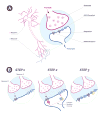Synaptic Plasticity: The Role of Learning and Unlearning in Addiction and Beyond
- PMID: 27697156
- PMCID: PMC5347979
- DOI: 10.1016/j.biopsych.2016.09.002
Synaptic Plasticity: The Role of Learning and Unlearning in Addiction and Beyond
Conflict of interest statement
All authors report no biomedical financial interests or potential conflicts of interest.
Figures

Comment on
-
AMPA Receptor Plasticity in Accumbens Core Contributes to Incubation of Methamphetamine Craving.Biol Psychiatry. 2016 Nov 1;80(9):661-670. doi: 10.1016/j.biopsych.2016.04.003. Epub 2016 Apr 12. Biol Psychiatry. 2016. PMID: 27264310 Free PMC article.
References
-
- Neruda P. Twenty Love Poems and a Song of Despair. New York: Penguin; 1969.
-
- Draaisma D. Metaphors of Memory: A History of Ideas About the Mind. Cambridge: Cambridge University Press; 2000.
-
- Cajal SRY. The Croonian Lecture: La fine structure des centres nerveux. Proc R Soc Lond. 1894;55:444–468.
-
- Hebb DO. The Organization of Behavior: A Neuropsychological Theory. New York: Psychology Press; 2005.
-
- Castellucci V, Pinsker H, Kupfermann I, Kandel ER. Neuronal mechanisms of habituation and dishabituation of the gill-withdrawal reflex in Aplysia. Science. 1970;167:1745–1748. - PubMed
Publication types
MeSH terms
Grants and funding
LinkOut - more resources
Full Text Sources
Other Literature Sources

